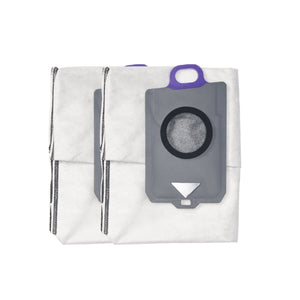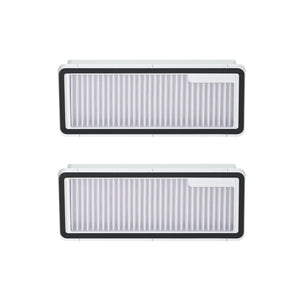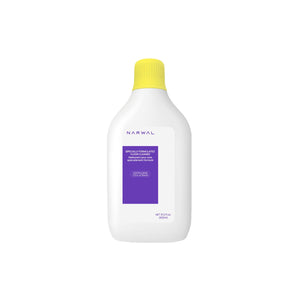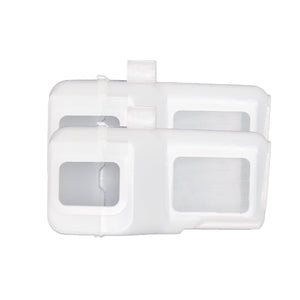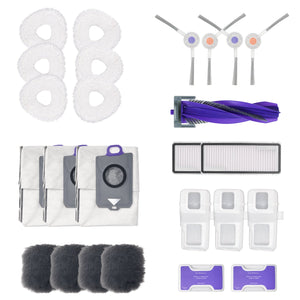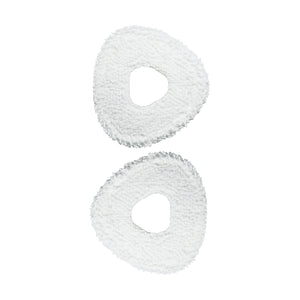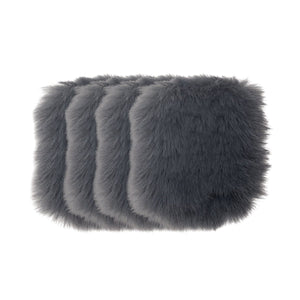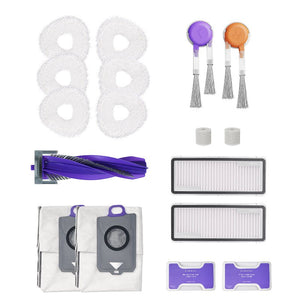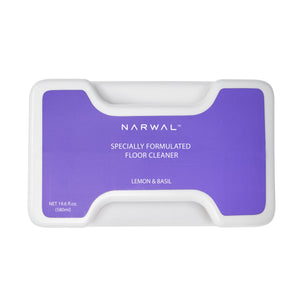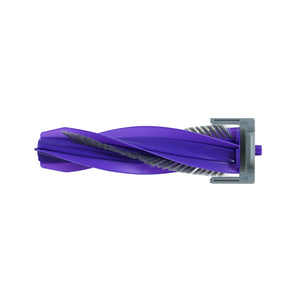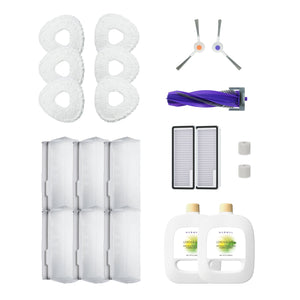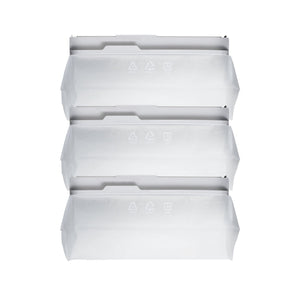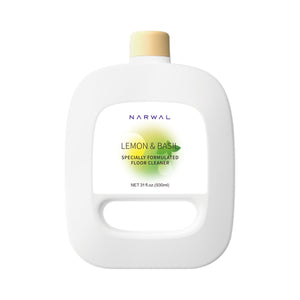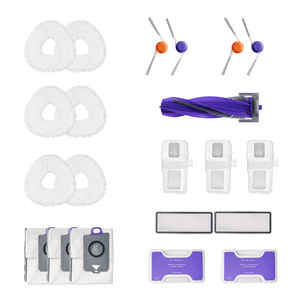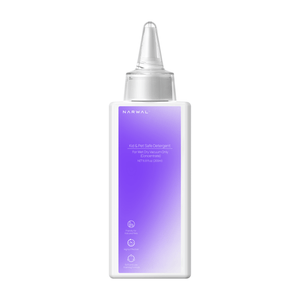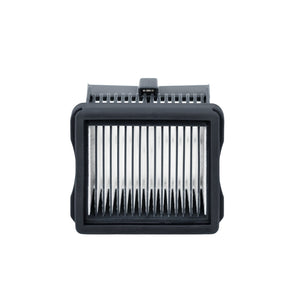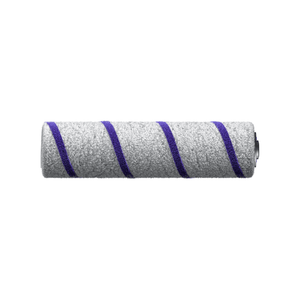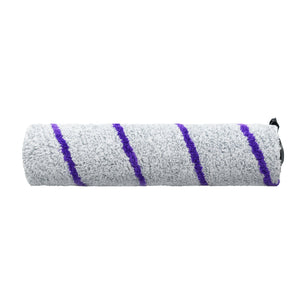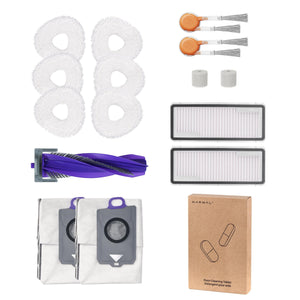Can you imagine a world where cleaning at home or work is not a concern? Robot vacuum cleaners have revolutionized our approach to cleanliness. So, choosing between a commercial and residential robot vacuum can be challenging.
Although their primary goal is to clean floors, they differ significantly in their capabilities, traits, and applications. Let's examine the slight variations that differentiate them.
Commercial vs Household Robot Vacuums: Which One Fits You?
Use a Commercial Robot Vacuum if you...
-
Manage or clean large areas like offices, hotels, or clinics
-
Need powerful suction, long battery life, and larger dustbins
-
Want to automate heavy-duty cleaning with minimal supervision
-
Prioritize durability and performance over cost or compact design
Use a Household Robot Vacuum if you...
-
Clean typical home spaces with dust, crumbs, or pet hair
-
Prefer voice or app control and smart home integration
-
Need a compact vacuum for tight spaces and furniture navigation
-
Want an affordable, easy-to-maintain cleaning solution for daily use
What Is a Commercial Robot Vacuum?
A commercial robotic vacuum is a high-powered cleaning machine built for large-scale environments such as offices or hotels. As a commercial-grade vacuum robot, it offers stronger suction, extended battery life, and greater dustbin capacity compared to household models.
Key Features of Commercial Robot Vacuums
-
High Suction Power: Captures dust, debris, and larger messes efficiently.
-
Long Battery Life: Runs up to 8 hours to clean large spaces in one go.
-
Durable Build: Made with heavy-duty materials for extended use.
-
Advanced Navigation: Uses lidar or smart mapping for efficient coverage.
-
Large Dustbin Capacity: Reduces the frequency of manual emptying.
Pros and Cons
Pros:
-
Cleans large areas quickly and thoroughly
-
High performance and industrial-grade reliability
-
Reduces labor and manual cleaning workload
Cons:
-
Higher upfront cost
-
May be bulky and loud
-
Often requires professional setup or maintenance
Where Commercial Robot Vacuums Work Best
-
Large open-plan offices
-
Retail floors and hotel lobbies
-
Warehouses or industrial facilities
-
Schools, clinics, or busy public spaces
acuums are suitable for domestic use, prioritizing convenience and making home cleaning easier. They are also ideal for everyday cleaning, ensuring your house remains free from dirt, dust, and pet hair.

What Is a Household Robot Vacuum?
A household robot vacuum is designed for regular home use, focusing on convenience and automation. These devices handle daily dust, pet hair, and light messes in apartments or houses without the need for manual cleaning.
Key Features of Household Robot Vacuums
-
Compact Size: Easily fits under furniture and around tight spaces.
-
Sufficient Suction: Handles crumbs, pet hair, and everyday floor dust.
-
User-Friendly Controls: Most models come with simple apps or remote programming.
-
Smart Connectivity: Many integrate with Alexa, Google Home, or app scheduling.
-
Affordable Pricing: Ideal for most households, with budget-friendly options.
FURTHER READING
A Robot That Makes House Cleaning Pleasant
Pros and Cons
Pros:
-
Simple to set up and operate, even for first-time users
-
Good fit for homes with pets, kids, or daily messes
-
Low maintenance and energy-efficient
Cons:
-
Less effective on deep or industrial messes
-
Small dustbin fills up quickly
-
Shorter runtime, not ideal for large homes
Where Household Robot Vacuums Work Best
-
Apartments and condos: Efficient for everyday upkeep in limited spaces
-
Homes with pets: Helps reduce shedding buildup and allergens
-
Busy households: Keeps floors tidy between deep cleaning sessions

Commercial vs Residential Robot Vacuums: Which Should You Choose?
Robot vacuums come in two main types: commercial and residential. This chart shows the key differences at a glance:
Quick Comparison: Commercial vs Residential Robot Vacuums
|
Feature |
Commercial Robot Vacuum |
Residential Robot Vacuum |
|
Cleaning Strength |
High suction, for big messes |
Moderate suction, for daily use |
|
Battery Life |
Long run time, 4–8 hours |
Shorter run time, 1–2 hours |
|
Dustbin Size |
Large, less emptying |
Small, needs frequent emptying |
|
Smart Features |
Basic scheduling |
App control, voice commands |
|
Setup |
May need technician |
Easy setup, app-friendly |
|
Best For |
Offices, hotels, schools |
Homes, apartments, pet owners |
|
Budget |
High budget |
Low to mid budget |
Detailed Comparison: Understanding the Differences
Cleaning Strength
Commercial vacuums are built to remove dirt from large, busy areas. For example, they can clean mud from school hallways or dust from hotel lobbies. This is because they use stronger motors and wider brushes. Residential vacuums don’t need that much power. They’re made to pick up daily dust, crumbs, and pet hair in a small home. If you don’t deal with heavy messes, the extra strength isn’t needed.
Battery Life
Longer battery life means a machine can clean longer without stopping. Commercial vacuums can run for several hours because large areas take more time. In a home, a short cleaning time is usually enough. A vacuum that runs for an hour can clean a kitchen, living room, and bedroom before needing a recharge.
Dustbin Size
A larger dustbin matters in public areas with a lot of foot traffic. Imagine cleaning a school hallway that collects dirt all day—it needs more room. At home, smaller bins are okay. But if you have pets that shed often, you may still need to empty it more than once a day.
Smart Features
Most home robot vacuums connect to apps and can follow voice commands like “clean the kitchen.” This makes daily cleaning simple and hands-free. Commercial vacuums are used by staff or on fixed schedules. Many don’t need app features because someone starts the job manually. These machines focus more on power and reliability than smart controls.
Setup and Maintenance
Home vacuums are made for anyone to use right out of the box. They’re simple to charge and start. Commercial vacuums might need trained staff to set them up, especially if they’re part of a cleaning team’s tools. They may also need more complex maintenance over time.
Who They’re For
If you clean a hotel, office, or school hallway every day, commercial vacuums are the right tool. They clean better, last longer, and save labor. If you clean your home once a day or a few times a week, a residential vacuum gives you the features you need without spending too much.
Budget Fit
Commercial models are an investment. The higher cost pays off in places where the machine works every day for hours. Residential models cost less and fit into most household budgets. They’re good for everyday help, not heavy-duty use.
Best Commercial Robot Vacuums: What to Look For
If you're looking to invest in a commercial robot vacuum, it's important to focus on features that directly impact performance and efficiency in larger or busier spaces. Here are the key factors to consider:
Suction Power and Cleaning Performance
Look for a machine with high suction power (above 3000Pa) capable of lifting both fine dust and larger debris on hard floors and low-pile carpets. Consistent suction is crucial in high-traffic commercial areas.
Runtime and Battery Capacity
Choose models with long-lasting batteries (2–8 hours) that can handle cleaning entire floors or rooms without frequent recharging. Docking stations for auto-recharge can enhance productivity.
Dustbin Size and Maintenance
A larger dustbin minimizes downtime. For industrial use, opt for 1-liter+ capacity or models that support automatic dust disposal.
Navigation and Mapping Technology
Advanced lidar or AI-based navigation systems help cover large, open areas efficiently. Look for multi-floor mapping if you manage a multi-level building.
Durability and Materials
Commercial models should be built with high-grade components that withstand daily or continuous operation, often under tougher conditions than in a home.
Integration Capabilities
Some high-end commercial vacuums offer compatibility with facility management systems or scheduling via apps, which is useful for property managers and custodial teams.
Noise Level (Optional)
If used in offices or clinics during work hours, quieter operation (below 60dB) may be essential to avoid disruptions.
Choosing the right robot vacuum for commercial use depends on your cleaning frequency, floor type, and available staffing. For businesses with high foot traffic, investing in a commercial robotic vacuum ensures reliable, consistent cleaning.
Conclusion
Understanding the differences between commercial and household robot vacuums is crucial before buying. Commercial robot vacuums are perfect for big-scale tasks. They possess strong capabilities, increased size, and strength. Likewise, robotic vacuum cleaners for the home offer convenience, simplicity, and integration with smart home systems.
Therefore, they are ideal for carrying out regular household cleaning tasks. When selecting a robotic vacuum, consider the size of the cleaning space, your cleaning requirements, and the maintenance you can handle. Investing in a commercial model can lead to considerable efficiency improvements and labor cost savings for companies.
In households, a robotic vacuum helps to maintain cleanliness effortlessly, blending smoothly into your everyday schedule. So, when buying a new cleaning product, identify what matters most to you and select the option that fits your lifestyle or business requirements. After all, living a clean lifestyle is achievable with the help of a robot.
Are you ready to elevate your cleaning routine with a robot vacuum? Explore top-rated household robot vacuums or learn about commercial-grade models to suit your business needs.
Contact our live website chat for more inquiries about the latest updates regarding our products. We will also provide tips on maintaining a spotless environment with the help of smart technology!
FAQs
What Makes a Robot Vacuum Commercial Grade?
A commercial-grade robot vacuum is built for extended use in large, high-traffic areas. It typically features higher suction power (3000Pa+), longer battery life (2–8 hours), a larger dustbin, and advanced navigation systems. These vacuums are often made with more durable components to withstand daily operation in office, retail, or industrial spaces.
Can I Use a Commercial Robot Vacuum at Home?
Yes, you can—but it’s often unnecessary. Commercial robot vacuums are bulkier, louder, and more expensive than household models. Unless you have a very large home or specific cleaning needs (like pet boarding, home clinics, or studios), a household robot vacuum is usually more practical and cost-effective.
What’s the Difference Between Commercial and Heavy-Duty Robot Vacuums?
Heavy-duty robot vacuums are designed for homes with higher cleaning demands—like multiple pets or frequent messes. They offer stronger suction and larger dustbins than standard household models but may not match the endurance, automation, or navigation tech of true commercial models used in professional environments.
Do Commercial Robot Vacuums Work on Carpet?
Yes, but with limitations. Most commercial robot vacuums perform best on hard floors and low-pile carpets. For thick or plush carpets, they may struggle with maneuverability and suction efficiency unless specifically designed for that surface. If your space includes carpets, look for models with carpet boost modes and brush rolls.
How Long Do Commercial Robot Vacuums Last?
With proper maintenance, commercial robot vacuums can last 3–5 years or more. Their components are built for durability, but longevity depends on usage frequency, cleaning environment, and upkeep. Regular filter replacements, brush cleaning, and battery care can significantly extend their lifespan.
Can Robot Vacuums Replace Janitorial Staff in Commercial Spaces?
Not entirely. Robot vacuums can reduce the manual workload and handle routine floor cleaning, but they cannot yet replace all cleaning tasks such as trash removal, restroom sanitization, or cleaning complex obstacles. They work best as part of a hybrid solution that enhances cleaning efficiency.
What’s the Typical Cost of a Commercial Robot Vacuum?
Commercial robot vacuums usually range from $800 to over $3,000 depending on features like mapping, self-emptying, battery size, and smart integrations. More advanced models with AI navigation and auto-cleaning stations tend to sit at the higher end of this range.





















